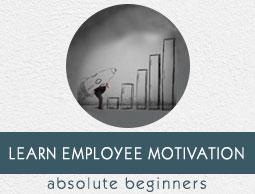Employee Motivation - Key Factors
There is an old saying that, you can lead a horse to water, but you cannot make it to drink; it will drink only if it's thirsty. The same logic applies to people in general. They will do what they want to do or otherwise only if they are motivated to do. Whether it is to excel on the workshop floor or in the 'ivory tower' they must be motivated or driven to it, either by themselves or through external stimuli.
Human beings are self-motivated if they find the job and organization suitable to their personality type. If they are not motivated they can be motivated by various methods as discussed in the above chapters. This is cardinal for any business to survive and succeed.

Performance is considered to be a function of ability and motivation, thus −
Job Performance = f(ability) (motivation)
Ability in turn depends on education, experience and training and its improvement is a slow and long process. On the other hand, motivation can be improved quickly. There are many options and an uninitiated manager may not even know how and where to start.
Broadly, there are Sevens Strategies for motivation −
- Positive reinforcement
- Effective discipline and punishment
- Treating people fairly
- Satisfying employees needs
- Setting work related goals
- Restructuring jobs
- Base rewards on job performance
These are the basic strategies, though the mix in the final 'recipe' will vary from workplace situation to situation. Essentially, there is a gap between an individual’s actual state and some desired state and the manager tries to reduce this gap.
How to Create a Motivated Organization?
The development and growth of an organization is not possible only if only the employees are motivated; the organization as a whole need to be motivated. And motivating an organization is not an easy task. s motivated organization as a whole which is necessary for the betterment and the growth of the organization in reaching its goals.
Motivation and Organizational Theory
Though we have discussed motivation extensively earlier, the role of the HR department and the role of the organizational culture in motivating employees have not been discussed at length.
As organizational theory states, employees need to be motivated to actualize their potential and there are several ways of enabling them and empowering them to do so. These include the role of reward systems in motivating employees according to their needs for extrinsic or external motivation and by providing them opportunities that appeal to their intrinsic or internal motivation needs.
For example, there are many multinationals like Fidelity where the HR managers hold one to one sessions with the employees to foster an open and inclusive culture where employees do not hold anything back and where they are encouraged to be as forthright as possible.
How to Create a Motivational Job?
The workplace environment affects how the employees perform and feel about their jobs. A motivating workplace encourages employees to work harder, which allows them to advance and succeed while your business gets ahead.
The employees may also be more satisfied with their jobs when the environment motivates them at the office. Money often comes to mind as a motivating factor for employees, but other strategies also work to encourage improved work performance from all staff members.
Nowadays, leaders are looking for ways to keep their employees focused and motivated during challenging economic and business conditions. With layoffs, pay freezes, furloughs, and 401K cuts, there’s plenty of bad news going on that a leader can’t control that can drag a team down.

A motivating environment is when people are pushing themselves harder than any boss could ever push them. It’s when people are giving it their all when no one is watching and no one may ever know. They’re giving 110% because they want to, not because they have to.
Here is a set of ideas that you can follow to create motivation in employees at
workplace −
- Create motivating work
- Hire 'A' players and get rid of 'C' players
- Don’t micromanage
- Promote your team’s work
- Loosen up the rules and bureaucracy
- Set a good example
- Encourage camaraderie during work hours
- Pay people for what they are worth




